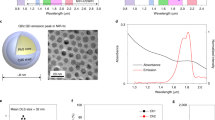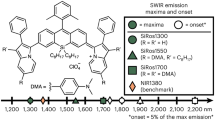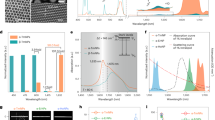Abstract
For in vivo imaging, the short-wavelength infrared region (SWIR; 1,000–2,000 nm) provides several advantages over the visible and near-infrared regions: general lack of autofluorescence, low light absorption by blood and tissue, and reduced scattering. However, the lack of versatile and functional SWIR emitters has prevented the general adoption of SWIR imaging by the biomedical research community. Here, we introduce a class of high-quality SWIR-emissive indium-arsenide-based quantum dots that are readily modifiable for various functional imaging applications, and that exhibit narrow and size-tunable emission and a dramatically higher emission quantum yield than previously described SWIR probes. To demonstrate the unprecedented combination of deep penetration, high spatial resolution, multicolour imaging and fast acquisition speed afforded by the SWIR quantum dots, we quantified, in mice, the metabolic turnover rates of lipoproteins in several organs simultaneously and in real time as well as heartbeat and breathing rates in awake and unrestrained animals, and generated detailed three-dimensional quantitative flow maps of the mouse brain vasculature.
This is a preview of subscription content, access via your institution
Access options
Access Nature and 54 other Nature Portfolio journals
Get Nature+, our best-value online-access subscription
$29.99 / 30 days
cancel any time
Subscribe to this journal
Receive 12 digital issues and online access to articles
$99.00 per year
only $8.25 per issue
Buy this article
- Purchase on Springer Link
- Instant access to full article PDF
Prices may be subject to local taxes which are calculated during checkout







Similar content being viewed by others
References
De Jong, M., Essers, J. & van Weerden, W. M. Imaging preclinical tumour models: improving translational power. Nat. Rev. Cancer 14, 481–493 (2014).
Welsher, K. et al. A route to brightly fluorescent carbon nanotubes for near-infrared imaging in mice. Nat. Nanotech. 4, 773–780 (2009).
Yi, H. et al. M13 phage-functionalized single-walled carbon nanotubes as nanoprobes for second near-infrared window fluorescence imaging of targeted tumors. Nano Lett. 12, 1176–11 83 (2012).
Hong, G. et al. Through-skull fluorescence imaging of the brain in a new near-infrared window. Nat. Photon. 8, 723–730 (2014).
Ghosh, D. et al. Deep, noninvasive imaging and surgical guidance of submillimeter tumors using targeted M13-stabilized single-walled carbon nanotubes. Proc. Natl Acad. Sci. USA 111, 13948–139 53 (2014).
Bardhan, N. M., Ghosh, D. & Belcher, A. M. Carbon nanotubes as in vivo bacterial probes. Nat. Commun. 5, 4918 (2014).
Welsher, K., Sherlock, S. P. & Dai, H. Deep-tissue anatomical imaging of mice using carbon nanotube fluorophores in the second near-infrared window. Proc. Natl Acad. Sci. USA 108, 8943–8948 (2011).
Hong, G. et al. Multifunctional in vivo vascular imaging using near-infrared II fluorescence. Nat. Med. 18, 1841–1846 (2012).
Naczynski, D. J. et al. Rare-earth-doped biological composites as in vivo shortwave infrared reporters. Nat. Commun. 4, 2199 (2013).
Lim, Y. T. et al. Selection of quantum dot wavelengths for biomedical assays and imaging. Mol. Imaging 2, 50–64 (2003).
Hong, G. et al. Ultrafast fluorescence imaging in vivo with conjugated polymer fluorophores in the second near-infrared window. Nat. Commun. 5, 4206 (2014).
Tsukasaki, Y. et al. Short-wavelength infrared emitting mutimodal probe for non-invasive visualization of phagocyte cell migration in living mice. Chem. Commun. 50, 14356–1435 9 (2014).
Tao, Z. et al. Biological imaging using nanoparticles of small organic molecules with fluorescence emission at wavelengths longer than 1000 nm. Angew. Chem. Int. Ed. 52, 13002–1300 6 (2013).
Dong, B. et al. Facile synthesis of highly photoluminescent Ag2Se quantum dots as a new fluorescent probe in the second near-infrared window for in vivo imaging. Chem. Mater. 25, 2503–2509 (2013).
Zhu, C.-N. et al. Ag2Se quantum dots with tunable emission in the second near-infrared window. ACS Appl. Mater. Interfaces 5, 1186–1189 (2013).
Zhang, Y. Y. et al. Ag2S quantum dot: a bright and biocompatible fluorescent nanoprobe in the second near-infrared window. ACS Nano 6, 3695–3702 (2012).
Tsukasaki, Y. et al. Synthesis and optical properties of emission-tunable PbS/CdS core–shell quantum dots for in vivo fluorescence imaging in the second near-infrared window. RSC Adv. 4, 41164–41171 (2014).
Chen, O. et al. Compact high-quality CdSe–CdS core–shell nanocrystals with narrow emission linewidths and suppressed blinking. Nat. Mater. 12, 445–451 (2013).
Franke, D. et al. Continuous injection synthesis of indium arsenide quantum dots emissive in the short-wavelength infrared. Nat. Commun. 7, 12749 (2016).
Zhang, Y. et al. Biodistribution, pharmacokinetics and toxicology of Ag2S near-infrared quantum dots in mice. Biomaterials 34, 3639–3646 (2013).
Dubertret, B. et al. In vivo imaging of quantum dots encapsulated in phospholipid micelles. Science 298, 1759–1762 (2002).
Stroh, M. et al. Quantum dots spectrally distinguish multiple species within the tumor milieu in vivo. Nat. Med. 11, 678–682 (2005).
Bruns, O. T. et al. Real-time magnetic resonance imaging and quantification of lipoprotein metabolism in vivo using nanocrystals. Nat. Nanotech. 4, 193–201 (2009).
Bartelt, A. et al. Brown adipose tissue activity controls triglyceride clearance. Nat. Med. 17, 200–205 (2011).
Heeren, J. & Bruns, O. Nanocrystals, a new tool to study lipoprotein metabolism and atherosclerosis. Curr. Pharm. Biotechnol. 13, 365–372 (2012).
Fay, F. et al. Nanocrystal core lipoprotein biomimetics for imaging of lipoproteins and associated diseases. Curr. Cardiovasc. Imaging Rep. 6, 45–54 (2013).
Jung, C. et al. Intraperitoneal injection improves the uptake of nanoparticle-labeled high-density lipoprotein to atherosclerotic plaques compared with intravenous injection: a multimodal imaging study in ApoE knockout mice. Circ. Cardiovasc. Imaging 7, 303–311 (2014).
Jacobs, G. H., Neitz, J. & Deegan, J. F. Retinal receptors in rodents maximally sensitive to ultraviolet light. Nature 353, 655–656 (1991).
Foster, H. L., Small, J. D. & Fox, J. G. The Mouse in Biomedical Research: Normative Biology, Immunology, and Husbandry (Academic Press, 2006).
Berndt, A., Leme, A. S., Paigen, B., Shapiro, S. D. & Svenson, K. L. Unrestrained plethysmograph and anesthetized forced oscillation methods of measuring lung function in 29 inbred strains of mice. Mouse Phenome Databasehttp://phenome.jax.org/db/q?rtn=projects/projdet&reqprojid=351 (2010).
Hillman, E. M. C. & Moore, A. All-optical anatomical co-registration for molecular imaging of small animals using dynamic contrast. Nat. Photon. 1, 526–530 (2007).
Kamoun, W. S. et al. Simultaneous measurement of RBC velocity, flux, hematocrit and shear rate in vascular networks. Nat. Methods 7, 655–660 (2010).
Adrian, R. J. Twenty years of particle image velocimetry. Exp. Fluids 39, 159–169 (2005).
Adrian, R. J. Particle-imaging techniques for experimental fluid mechanics. Annu. Rev. Fluid Mech. 23, 261–304 (1991).
Shi, Y., Cheng, J. C., Fox, R. O. & Olsen, M. G. Measurements of turbulence in a microscale multi-inlet vortex nanoprecipitation reactor. J. Micromech. Microeng. 23, 75005 (2013).
Schindelin, J. et al. Fiji: an open-source platform for biological-image analysis. Nat. Methods 9, 676–682 (2012).
Aharoni, A., Mokari, T., Popov, I. & Banin, U. Synthesis of InAs/CdSe/ZnSe core/shell1/shell2 structures with bright and stable near-infrared fluorescence. J. Am. Chem. Soc. 128, 257–264 (2006).
Li, J. J. et al. Large-scale synthesis of nearly monodisperse CdSe/CdS core/shell nanocrystals using air-stable reagents via successive ion layer adsorption and reaction. J. Am. Chem. Soc. 125, 12567–12575 (2003).
Hines, M. A. & Scholes, G. D. Colloidal PbS nanocrystals with size-tunable near-infrared emission: observation of post-synthesis self-narrowing of the particle size distribution. Adv. Mater. 15, 1844–1849 (2003).
Pietryga, J. M. et al. Utilizing the lability of lead selenide to produce heterostructured nanocrystals with bright, stable infrared emission. J. Am. Chem. Soc. 130, 4879–4885 (2008).
Supran, G. J. et al. High-performance shortwave-infrared light-emitting devices using core–shell (PbS–CdS) colloidal quantum dots. Adv. Mater. 27, 1437–1442 (2015).
Folch, J., Lees, M. & Sloane Stanley, G. H. A simple method for the isolation and purification of total lipides from animal tissues. J. Biol. Chem. 226, 497–509 (1957).
Wurdinger, T. et al. A secreted luciferase for ex vivo monitoring of in vivo processes. Nat. Methods 5, 171–173 (2008).
Kodack, D. P. et al. Combined targeting of HER2 and VEGFR2 for effective treatment of HER2-amplified breast cancer brain metastases. Proc. Natl Acad. Sci. USA 109, E3119–E3127 (2012).
Kloepper, J. et al. Ang-2/VEGF bispecific antibody reprograms macrophages and resident microglia to anti-tumor phenotype and prolongs glioblastoma survival. Proc. Natl Acad. Sci. USA 113, 4476–4481 (2016).
Neher, R. A. et al. Blind source separation techniques for the decomposition of multiply labeled fluorescence images. Biophys. J. 96, 3791–3800 (2009).
Meinhart, C. D., Wereley, S. T. & Santiago, J. G. A PIV algorithm for estimating time-averaged velocity fields. J. Fluids Eng. 122, 285–289 (2000).
Marxen, M., Sullivan, P. E., Loewen, M. R., Èhne, B. J. & Jähne, B. Comparison of Gaussian particle center estimators and the achievable measurement density for particle tracking velocimetry. Exp. Fluids 29, 145–153 (2000).
Acknowledgements
This work received support from the US National Institutes of Health (NIH) in part through 5-U54-CA151884 (M.G.B.), P01-CA080124 (R.K.J. and D.Fukumura), R35 CA197743, P50 CA165962 and R01-CA126642 (R.K.J.), R01-CA096915 (D.Fukumura), the NIH funded Laser Biomedical Research Center through 4-P41-EB015871-30 (M.G.B.), and the US National Cancer Institute/Federal Share Proton Beam Program Income (R.K.J.); the US National Foundation for Cancer Research (R.K.J.), and the Warshaw Institute for Pancreatic Cancer Research and Massachusetts General Hospital Executive Committee on Research (D.Fukumura); the US Army Research Office through the Institute for Soldier Nanotechnologies (W911NF-13-D-0001; J.A.C., O.C., H.W., G.W.H. and M.G.B.); the US Department of Defence through DoD W81XWH-10-1-0016 (R.K.J.); and the US National Science Foundation (NSF) through ECCS-1449291 (D.Franke and M.G.B.). This work was supported as part of the Massachusetts Institute of Technology (MIT) Center for Excitonics, an Energy Frontier Research Center funded by the US Department of Energy, Office of Science, Office of Basic Energy Sciences under Award Number DE-SC0001088 (T.S.B. and M.W.B.W.). O.T.B. is supported by an European Molecular Biology Organization long-term fellowship. A.B. is supported by a Deutsche Forschungsgemeinschaft Research Fellowship (BA 4925/1-1). D.Franke is supported by a fellowship of the Evonik Stiftung and fellowship of the Boehringer Ingelheim Fonds. This research was conducted with government support under and awarded by the US Department of Defence, Air Force Office of Scientific Research, National Defence Science and Engineering Graduate Fellowship 32 CFR 168a (J.A.C.). J.H. is supported by a grant from the Fondation Leducq—Triglyceride Metabolism in Obesity and Cardiovascular Disease. L.R. received a Mildred Scheel Fellowship (Deutsche Krebshilfe). D.K.H., D.M.M., I.C. and O.B.A. were supported by NSF GRFP fellowships. J.K. was supported by fellowships from the Deutsche Forschungsgemeinschaft and the SolidarImmun Foundation. C.J.R. and P.T.C.S. acknowledge support from NIH 4-P41-EB015871-30, DP3-DK101024 01, 1-U01-NS090438-01, 1-R01-EY017656 -0, 6A1, 1-R01-HL121386-01A1, the Biosym IRG of Singapore–MIT Alliance Research and Technology Center, the Koch Institute for Integrative Cancer Research Bridge Initiative, Hamamatsu Inc., and the Samsung GRO program. We thank S. Roberge and P. Huang for technical assistance. We also thank QDVision for providing an InAs–CdZnS QD sample (InAs-016) used in this study. We are grateful to Gökhan Hotamisligil for critical discussion and continuing support.
Author information
Authors and Affiliations
Contributions
O.T.B., T.S.B., D.K.H., D.Franke, L.R., A.B., F.B.J., J.A.C., M.W.B.W., O.C., H.W., G.W.H., D.M.M., I.C., O.B.A. and J.K. performed the experiments. O.T.B, T.S.B., Y.S. and C.J.R. analysed the data, O.T.B., T.S.B. and M.G.B. wrote the paper and were assisted by D.Franke, A.B. and R.K.J. J.H., P.T.C.S, D.Fukumura, K.F.J. and R.K.J. provided guidance on the study design. J.H. provided lipid samples. All authors reviewed and edited the manuscript.
Corresponding authors
Ethics declarations
Competing interests
The authors declare no competing financial interests.
Supplementary information
Supplementary Information
Supplementary figures and video captions. (PDF 6792 kb)
Supplementary Video 1
Five InAs core-shell quantum dot samples with distinct emission spectra, dissolved in hexanes. Please refer to the Supplementary Information file for the full description. (MOV 2521 kb)
Supplementary Video 2
SWIR emission from a mouse with activated brown adipose tissue. Please refer to the Supplementary Information file for the full description. (MOV 1309 kb)
Supplementary Video 3
Biodistribution of PEGylated SWIR QDs (1,200 nm emission) in a mouse. Please refer to the Supplementary Information file for the full description. (MOV 5674 kb)
Supplementary Video 4
Same as Supplementary Video 3, after reaching equilibrium. Please refer to the Supplementary Information file for the full description. (MOV 4812 kb)
Supplementary Video 5
Awake mouse injected with PEGylated QDs emitting at 1,080 nm. Please refer to the Supplementary Information file for the full description. (MOV 4035 kb)
Supplementary Video 6
Imaging of the brain of a mouse with glioblastoma multiforme through a cranial window, during injection of PEGylated QDs. Please refer to the Supplementary Information file for the full description. (MOV 29665 kb)
Supplementary Video 7
High-speed intravital SWIR microscopy in the healthy hemisphere of a mouse's brain. Please refer to the Supplementary Information file for the full description. (MOV 8493 kb)
Supplementary Video 8
High-speed intravital SWIR microscopy of the tumour margin of the mouse shown in Supplementary Video 7. Please refer to the Supplementary Information file for the full description. (MOV 8305 kb)
Supplementary Video 9
Z-stack images of blood flow in the brain of a mouse. Please refer to the Supplementary Information file for the full description. (AVI 2350 kb)
Supplementary Video 10
Z-resolved imaging of blood flow in the brain of a mouse. Please refer to the Supplementary Information file for the full description. (MOV 10131 kb)
Supplementary Video 11
Z-resolved imaging of blood flow in the brain of a mouse. Please refer to the Supplementary Information file for the full description. (MOV 7114 kb)
Supplementary Video 12
Z-resolved imaging of blood flow in the brain of a mouse. Please refer to the Supplementary Information file for the full description. (AVI 1801 kb)
Rights and permissions
About this article
Cite this article
Bruns, O., Bischof, T., Harris, D. et al. Next-generation in vivo optical imaging with short-wave infrared quantum dots. Nat Biomed Eng 1, 0056 (2017). https://doi.org/10.1038/s41551-017-0056
Received:
Accepted:
Published:
DOI: https://doi.org/10.1038/s41551-017-0056
This article is cited by
-
Oxyhaemoglobin saturation NIR-IIb imaging for assessing cancer metabolism and predicting the response to immunotherapy
Nature Nanotechnology (2024)
-
Noninvasive in vivo microscopy of single neutrophils in the mouse brain via NIR-II fluorescent nanomaterials
Nature Protocols (2024)
-
Very long wave infrared quantum dot photodetector up to 18 μm
Light: Science & Applications (2024)
-
Silicon photonics-based high-energy passively Q-switched laser
Nature Photonics (2024)
-
Silver telluride colloidal quantum dot infrared photodetectors and image sensors
Nature Photonics (2024)



